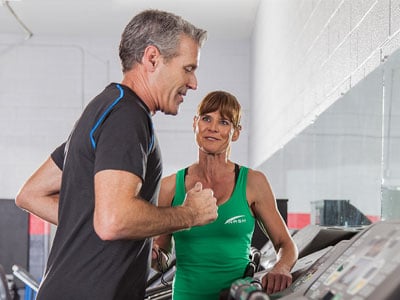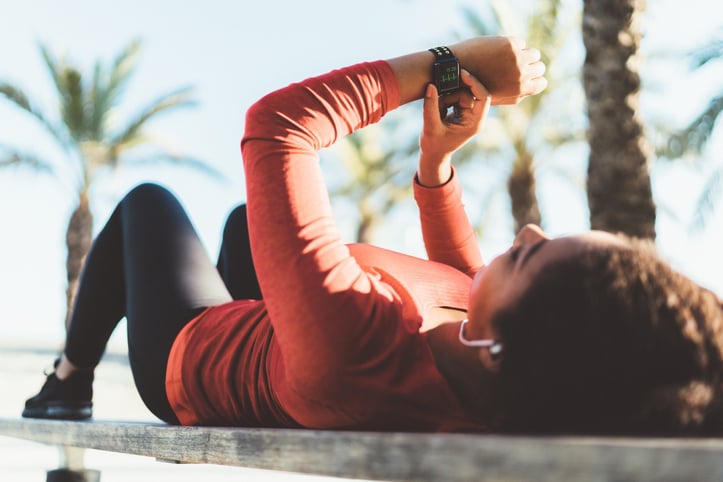Exercise can bring numerous benefits to older adults, both physically and psychologically, so why aren’t they active enough? Sometimes the biggest challenges to training this group, or even getting them to attempt any exercise at all, are their perceived barriers. How can we as fitness professionals help older adults transcend these perceptions and overcome these barriers?
As a personal trainer and health educator, I work with older adults more than any other population. One of the challenges I’m often faced with is a lack of interest in starting an exercise program, which is often perplexing since they demonstrate a clear understanding that more activity means better health. Based on this repeating experience, my objective became to better understand older adults, why they don’t exercise, and how we as guides can better motivate this growing demographic.
Older Adult Exercisers Are Few and Far Between
Some of the factors that influence how active we are include enjoyment, having social support, and believing that exercise is affecting us in a positive way (1). Another powerful influencer is the amount of perceived barriers an individual has to movement (1). For example, while many older adults believe exercising will have a positive impact on their health (2,3,4), their barriers to exercise prevail as the stronger influence (4). This is illustrated by the alarming number of older adults in America that aren’t getting enough exercise (1,4,5). In 2010, 52% of adults aged 55 to 64, and 61% over the age of 65, were not meeting the recommended guideline minimums for exercise (6). The result? Our growing elderly population is losing their independence, suffering poor health, and being burdened with escalating health care costs (4).
What Are Older Adults Up Against?
As a healthy, young personal trainer or health consultant, it’s hard to imagine the multiple hurdles older adults have to overcome before they even reach the starting line. Here are some common barriers:
- Self-efficacy
Self-efficacy refers to a person’s confidence in their ability to complete certain tasks. As we age, we lose that confidence for most activities, with the exception of walking (4). This loss can be attributed to perceptions of decreased fitness and body competency (2,3). Unfortunately, a sedentary lifestyle creates further deficits in perceived body competence, leading to the eventual fear of falling (7).
- Fear of Injury
When older adults render their bodies unfit and incompetent, developing a fear of injury is natural. Fear of falling, getting hurt, and general safety (7) are among the most commonly reported barriers older adults express (6,2,4). And, as mentioned above, sedentary lifestyle only exacerbates their losses in self-efficacy, and fear of safe locomotion (7).
- Inertia
Many older adults report general apathy or laziness as a reason for not exercising (7,3). Some find exercise itself to be boring (7); others report a lack of energy (3). Among minority groups, Latinas, and African American men and women said that they lacked the determination necessary to exercise (6).
- Depression and Anxiety
Older adults are dealing with more than just changes in body competency and mental sharpness – they may also be adjusting to the passing of loved ones, retirement, and having to care for frail persons older than themselves (2,4 6). Lees et al. reported in 2005 that negative affect, or feelings of depression, was among the top five reasons for reduced activity in both older adult exercisers and non-exercisers.
- Self-conscious
Older adults consider the worst part of aging to be the changes that occur to their physical appearance (2). Poor body image makes them fear exercising in gyms or other public areas (2,6).
- Health Problems
Chronic illness, disability, joint pain, etc., are common health problems that can keep older adults from exercising (6,7). They may fear pain, further injury or sickness, or simply assume that they can’t physically do the work.
- No Time
Older adults spend a lot of time at doctor visits and pharmacies, which they say doesn’t allow them time for exercise. Some older adults also feel further time-crunched from juggling multiple and substantial responsibilities, such as caring for a teenager and their older parents (2,6,7).
- Lack of Knowledge
Many minority groups report that they don’t know how to exercise without instruction (6). There’s also a belief that exercise has to be very strenuous and uncomfortable for it to be effective, keeping some older adults from even considering exercising (4).
- Lack of Support
Many sedentary older adults claim a major barrier to exercise is the lack of support from friends and family (4), whereas older adults who did exercise reported this barrier less often (7). This suggests that social support may be an important predictor of exercise initiation in older adults.
- Inconvenience, Cost and Community Structure are also barriers to exercise reported by older adults (6)
Ironically, Exercising is the Remedy for Barriers to Entry
What’s ironic is that exercising could improve or reverse the conditions that keep older adults from exercising in the first place (i.e., fear of falling, anxiety, depression, poor body competence, etc.). Older adults across ethnicities have reported improvements in productivity, self-esteem, mood, and overall health with increased physical activity (6). Exercising has also been shown to reduce the risk of falling and developing chronic conditions, such as heart disease, diabetes, cancer, and osteoporosis (5,6,1). It improves quality of life in people who are in poor health or disabled (1), increases feelings of self-efficacy (7, 2), and reduces levels of anxiety and depression (5,6,1).
What Can We Learn From Older Adults Who Do Exercise?
Luckily, research offers some helpful insights into why some older adults start exercising, and keep exercising.
Initial Motivators
- Desire to improve quality of life (2)
- Desire to improve appearance (4)
- Physician recommendation and support (but only when recommendations are specific, which is not common) (4)
- The prospect of positive health outcomes (6)
- Few barriers to entry and higher levels of self-efficacy (4)
Preferred Features
- Moderate intensity (4)
- Exercise appears safe (4)
- Simple schedules (4)
- Convenient location (4)
- Social component (mainly women) (4)
- Non-competitive environment (4)
- Low cost (4)
- Older adults with BMIs > 27 do not typically prefer class environments (4)
- Walking is the mode of choice across ethnicities (5,1)
Program Adherence Influencers
- Social support, like exercising with a friend (6)
- Senior-specific facilities (6)
- Convenience and low cost (4)
- Enjoyment (4)
- Transportation (4)
- Having an established routine (4)
How Can We Start Breaking Down Barriers?
Once we understand the types of concerns we can expect, we can start addressing them. Displaying compassion and sensitivity for personal barriers is critical to gaining a client’s trust, especially if your age differential creates a disconnect (2). Here is a simple list of ways to help you and your client overcome the most common barriers.
Fear of Injury
- Discuss their previous injuries, and describe the custom program you’ll build to accommodate them (2).
- Describe the use and benefit of a warm-up, stretching, and cool-down to help the client avoid pain and discomfort (2).
- Share with them the training you have completed to work with clients who have chronic conditions, such as arthritis, and that you understand the signs and symptoms to look for to ensure safety (2).
- Explain how exercise can help alleviate their joint aches and pains, and grant them greater flexibility and ease of movement (3).
Inertia
- Let them know they can start slowly, (e.g., 5-10 minute walks and 2-3 strength training exercises). Outline long-term goals to show them how their program will progress (3).
- Explore what may be causing their low energy (medicines, sadness over a passed loved one, poor fitness level, etc.). Explain to them how exercise will boost their energy level, and help them do more of the activities they love (3).
- Give them exercises and activities they find enjoyable, and also adjust and modify their program to prevent boredom (2,3).
No Time
- Be flexible, and show your clients that you’re willing to work around their busy schedules (2).
- Give them ways to integrate physical activity into their typical daily activities (e.g., chair exercises while waiting at the pharmacy) (2).
- If possible, meet them somewhere convenient and easily accessible for a workout, like their neighborhood park, or local walking trail (4).
- Ask them how they can be more active on their vacations, suggesting activities like hiking and kayaking (2).
Self-conscious
- When possible, point out other older adults that are in the gym working out (2).
- Introduce them to older adult exercise classes being offered at the health club. Find ways to show them that gyms are more senior-friendly than they may think (2).
Relevant blog posts to check out on senior fitness
- Exercise Programming for Older Adults
- Training Older and Younger Clients
- Exercise Programming for Hip Replacement
- Improving Posture for Older Clients
References:
- Physical activity and health: a report of the surgeon general executive summary. (1996). Centers for Disease Control and Prevention. http://www.cdc.gov/nccdphp/sgr/pdf/execsumm.pdf.
- Stone, J.J., Alexander, J.L., Thompson, C., Register-Mihalik, J., & Barefield, K. (2012). National Academy of Sports Medicine’s Senior Fitness Specialist Manual. Retrieved from https://www.dropbox.com/s/wn1gw6m1dkxj28p/sfs_manual_complete.pdf?dl=0.
- Six barriers to physical activity participation. (2011). U.S. Department of Health & Human Services’ Be Active Your Way Blog. http://www.health.gov/paguidelines/blog/post/Barriers-to-Physical-Activity-Among-Older-Adults.aspx.
- King, A.C. (2001). Interventions to promote physical activity in older adults. The Journal of Gerontology: Series A, 56A, 36-46. http://biomedgerontology.oxfordjournals.org/content/56/suppl_2/36.full.pdf+html.
- Belza, B., Walwick, J., Schwartz, S., LoGerfo, J., Shiu-Thornton, S., & Taylor, M. (2004). Older adult perspectives on physical activity and exercise: voices from multiple cultures. Preventing Chronic Disease: Public Health Research, Practice, and Policy, 1(4), A09. http://www.ncbi.nlm.nih.gov/pmc/articles/PMC1277949/pdf/PCD14A09.pdf.
- Mathews, A.E., Laditka, S.B., Laditka, J.N., Wilcox, S., Corwin, S.J., Liu, R., Friedman, D.B., Hunter, R., Tseng, W., & Logsdon, R.G. (2010). Older adults’ perceived physical activity enablers and barriers: a multicultural perspective. Journal of Aging & Physical Activity, 18, 119-140. http://journals.humankinetics.com/AcuCustom/Sitename/Documents/DocumentItem/17918.pdf.
- Lees, F.D., Clark, P.G., Nigg, C.R., & Newman, P. (2005). Barriers to exercise behavior among older adults: a focus-group study. Journal of Aging & Physical Activity, 13, 23-13. http://journals.humankinetics.com/AcuCustom/Sitename/Documents/DocumentItem/4512.pdf.
















